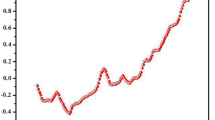Abstract
Carbon dioxide capture from ambient air could compensate for all carbon dioxide emissions to the atmosphere. Such capture would, for example, make it possible to use liquid, carbon-based fuels in cars or airplanes without negatively impacting the climate. We present a specific approach based on a solid sorbent in the form of an anionic exchange resin, that absorbs carbon dioxide when dry and releases it when exposed to moisture. We outline a particular implementation of such a moisture swing and discuss the scale of the collectors, the energy consumption, and the indirect carbon dioxide emissions related to the operation of carbon dioxide capture devices.
Similar content being viewed by others
References
G. Astarita, Mass Transfer with Chemical Reactions (Elsevier Publishing Company, Amsterdam, London, New York, 1967)
R. Baciocchi, G. Storti, M. Mazzotti, Process design and energy requirements for the capture of carbon dioxide from air, Chem. Eng. Proc. 45, 1047–1058 (2006)
A. Bandi, M. Specht, T. Weimer, K. Schaber, CO2 recycling for hydrogen storage and transportation - Electrochemical CO2 removal and fixation, Energy Conv. Manag. 36, 899–902 (1995)
S. Elliott, K.S. Lackner, H.-J. Ziock, M.K. Dubey, H.P. Hanson, S. Barr, N.A. Ciszkowski, D.R. Blake, Compensation of Atmospheric CO2 Buildup through Engineered Chemical Sinkage, Geophys. Res. Lett. 28, 1235–1238 (2001)
M.L. Gray, K.J. Champagne, D. Fauth, J.P. Baltrus, H. Pennline, Performance of immobilized tertiary amine solid sorbents for the capture of carbon dioxide, Int. J. Greenh. Gas Contr. 2, 3–8 (2008)
R. Joosten, J. Schumacher, C. Wirth, A. Schulte, Evaluating tree carbon predictions for beech (Fagus sylvatica L.) in western Germany, Forest Ecol. Manag. 189, 87–96 (2004)
D. Keith, M. Ha-Duong, J. Stolaroff, Climate Strategy with CO2 Capture from the Air, Climat. Change 74, 17–45 (2006)
K.S. Lackner, Thermodynamics of the Humidity Swing Driven Air Capture of Carbon Dioxide (GRT LLC, Tucson, AZ, 2008)
K.S. Lackner, H.-J. Ziock, P. Grimes, Carbon Dioxide Extraction from Air: Is it an Option? Proceedings of the 24th International Conference on Coal Utilization & Fuel Systems (Clearwater, Florida, 1999a)
K.S. Lackner, P. Grimes, H.-J. Ziock, Carbon Dioxide Extraction from Air? (Los Alamos National Laboratory, LAUR-99-5113, Los Alamos, NM, 1999b)
K.S. Lackner, C.H. Wendt, Exponential Growth of Large Self-Reproducing Machine Systems, Math. Comp. Modell. 21, 55–81 (1995)
B. Metz, O. Davidson, H.d. Coninck, M. Loos, L. Meyer, IPCC Special Report on Carbon Dioxide Capture and Storage (Cambridge University Press, New York, 2005)
F. Montagnini, P.K.R. Nair, Carbon sequestration: An underexploited environmental benefit of agroforestry systems, Agroforest. Syst. 61, 281–295 (2004)
T.E. Notteboom, Container Shipping and Ports: An Overview, Rev. Network Econom. 3, 86–106 (2004)
D. Sarewitz, R. Nelson, Three rules for technological fixes, Nature 456, 871–872 (2008)
M. Specht, A. Bandi, C.U. Maier, J. Schwarz, Energetics of solar methanol synthesis from atmospheric carbon dioxide compared to solar liquid hydrogen generation, Energy Conv. Manag. 33, 537–543 (1992)
N.A. Spector, B.F. Dodge, Removal of carbon dioxide from atmospheric air, Trans. Amer. Inst. Chem. Eng. 42, 827–848 (1946)
M. Steinberg, V.-D. Dang, Production of synthetic methanol from air and water using controlled thermonuclear reactor power–I. technology and energy requirement, Energy Conv. 17, 97–112 (1977)
J.K. Stolaroff, Capturing CO2 from ambient air: a feasibility assessment. Pittsburgh, Carnegie Mellon University, Doctor of Philosophy 85 (2006)
J.K. Stolaroff, D.W. Keith, G.V. Lowry, Carbon Dioxide Capture from Atmospheric Air Using Sodium Hydroxide Spray, Environm. Sci. Technol. 42, 2728–2735 (2008)
S. Stucki, A. Schuler, M. Constantinescu, Coupled CO2 recovery from the atmosphere and water electrolysis: Feasibility of a new process for hydrogen storage, Int. J. Hydr. Energy 20, 653–663 (1995)
F.S. Zeman, Air Extraction: The Feasibility of Absorbing CO2 directly from the Atmosphere. Earth and Environmental Engineering, Columbia University, Fu Foundation School of Engineering and Applied Sciences, New York, Doctor of Engineering Science 179 (2006)
F.S. Zeman, K.S. Lackner, Capturing Carbon Dioxide Directly from the Atmosphere, World Res. Rev. 16, 157–172 (2004)
Author information
Authors and Affiliations
Rights and permissions
About this article
Cite this article
Lackner, K. Capture of carbon dioxide from ambient air. Eur. Phys. J. Spec. Top. 176, 93–106 (2009). https://doi.org/10.1140/epjst/e2009-01150-3
Published:
Issue Date:
DOI: https://doi.org/10.1140/epjst/e2009-01150-3




